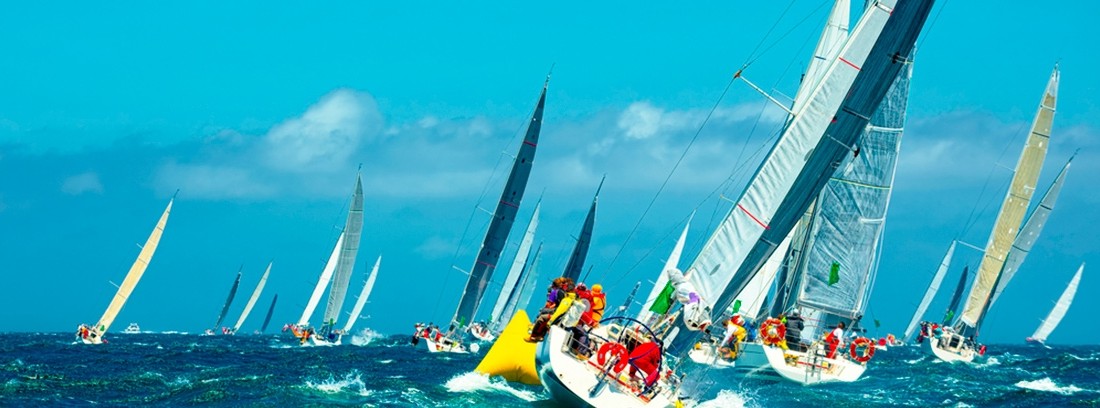Get to know sailing in depth

Plato: "There are three types of men: the living, the dead and those who sail." A metaphor, after all, but the truth is that this sailing is an art, a certain philosophy, a way of understanding life ... Apart from the mere means of transport used since ancient times, the truth is that in nowadays "sailing" is a particular sport. Use the wind to move along the Sea (yes, "the" Sea, in feminine, as any sailor knows) or the rivers. No noise, no rush, no stress, no expense; and, above all, very pleasantly. Our country, in particular, offers great possibilities for its practice, both because of the many kilometers of coastline and because of the very good weather conditions for its practice. Not surprisingly, this sport of sailing, in its competitive branch, is one of the ones that has given us the greatest number of Olympic medals. And now more technically… what does sailing consist of? : it is an authentic art, based on orienting the sails correctly to use the wind to our advantage and to be able to move the ship in the desired direction. In the old days, boats could only sail downwind: "sail either wing or stern." In "modern" sailing, however, we can still defy the laws of physics and get the sailboat to use the wind to even move in the opposite direction: "go bowline or upwind." The first courses are associated with the deployment ("hoisted") of the spectacular "balloon sails", often colored. The seconds, on the other hand, are linked, above all, with the inclination of the ships ("list") and the directions in "zigzag", allowing a wide margin of strategy in competition navigation.
Types of sailing
Considering modern sailing, there are two fundamental types of sailing: the "cruise" and the "regatta", obviously based on whether we sail for pleasure, "crossing" from one place to another, or if we compete to do a certain travel around buoys or from one port to another.
The "cruising sail" is the one envied by the sailor; Sailing for pleasure, liking to optimize the speed of the ship but not for being in a hurry but for the art and satisfaction of mastering this sport. Taken to the extreme is the "crossing", in which the cruise ship spends days (or months, or years ...) making trips from port to port, combining leisure with a good dose of adventure, and with the great satisfaction of achieving the goal.
These are heavier and more voluminous boats, with greater capacity in the fuel or fresh water tanks, with less number of m2 of sails, with greater number of comforts for the crew, therefore.
The "racing sail" is the one admired by everyone else; It is a pleasure, without a doubt, but in any case, the objective of competing and demonstrating skill in handling the boat and in interpreting the invisible, the wind, prevails.
Obviously, more extreme boats belong to this category, sharper, aggressive in their lines, with hardly any concessions to comforts, minimum fuel and water tanks, and maximum sail than allowed, since the objective is clear: to sail as fast. possible.
Within this «regatta sail» there is a very particular modality: For many, simply «the regatta!». A simple competition in his instructions: to go around the World, leaving the great capes of the South Seas on the left side of the ship ("the port side"); that is to say, facing, therefore, the most fearsome and demanding oceans and seas on the planet; And it is not worth navigating them, no! You have to do it faster than your rivals.
The VOR is an extreme regatta. It was born as an adventure but in a very few years it has become a navigation to the limit, both for the ship and its crew. Zero comforts! The boats are very demanding in their handling and their crews have to master many complicated factors to be the first: navigation, meteorology, physical training, mental training, food, hydration ...
Today, the VOR has become the benchmark regatta for modern sailing, along with the "Copa America de Vela". The one in oceanic sail, the other in sail around buoys, the truth is that they are both events of outstanding repercussion, to a good degree in Spain, to a maximum degree in countries such as New Zealand, France or the USA.
Benefits of sailing
But let's not lose focus… The VOR is just the icing on the cake. The real foundations of sailing are others: art, skill, wisdom ..., and also demanding physical exercise, adventure, teamwork par excellence ...!
- It is a sport free of age or gender limitations, closely linked to Nature, with an air of adventure and challenge.
- Its practice is a great exercise in proprioception from the first moment that one gets "on board", in need of compensating for the rocking of the ship itself.
- The humidity of the environment and, where appropriate, salinity, will favor us in the exchange of gases at the alveolar level.
- The obligatory nature of physical exercise (of moderate or high intensity, depending on the intensity of the wind) will stimulate both the heart pump and peripheral vascularization and musculoskeletal toning, in addition to venous return and lymphatic drainage.
- The teamwork that a boat demands is a great example of personal training and maturing.
- The level of endorphins generated and the satisfaction achieved are a great treatment against stress and greatly stimulate the subsequent night's rest.
- The bad part is…, that it creates addiction !, and one does not wait for the moment to return to sail.
MAPFRE WITH SPORTS
MAPFRE SALUD in its insurance offers you the most complete coverage and services so that you feel protected at all times.
(Updated at Apr 14 / 2024)